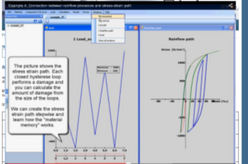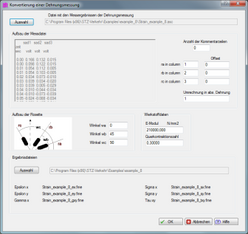Video Examples
Working through the examples will quickly familiarise you with the operation of the programme. This will save you time in the future. The data to be entered is shown in the winLIFE help. The video examples have been created over the last few years. Due to the further development of winLIFE, the user interface has changed slightly, so that there may be deviations in the display.

This example shows the basic operation of the programme using the nominal stress concept as an example.

In this example, a square notched plate with a thickness of 5 mm is calculated using the nominal stress method.

In this example, a square notched plate with a thickness of 5 mm is calculated according to the local concept (e.g. compare with example 2).

In this example, the design of the stress-strain path based on material memory alone is compared with the design of the stress-strain path based on the rainflow method. To do this, an example from the literature is recalculated.

Determine the component S-N curve for a rolled steel shaft subjected to bending and torsion. This should be compared with the FKM guideline.

A time-varying torsional moment and tensile/compressive forces are applied to a cylinder. The curve is entered manually, the data transfer is explained and the results are analysed.

The example could be a realistic engineering or automotive application. A control arm is loaded by two independent groups of forces for which measured values are available. The task is to calculate the fatigue life for the load spectrum determined by measurement.

A commercial vehicle rim is fitted with strain gauges and tested in the European cycle. The static preload caused by the air pressure and the dynamic strain caused by the deflection are analysed individually and suitably superimposed. Various equivalent stress hypotheses and damage parameters are analysed and compared with the test results.

winLIFE can be started with parameters via operating system commands - i.e. without a GUI. In this way, automatically running batch procedures can be defined. This is useful when similar problems need to be run repeatedly with only slightly changed parameters. In this example, the influence of fatigue limit on fatigue life is analysed. Starting from a project file, copies are made in which only the parameter to be varied, the fatigue limit, is changed. A batch file is created to automatically run several winLIFE calculations.

A simple gearbox is given with a ratio of 1:10. It consists of only two gear wheels made of the same material. The dwell time collective consists of only a few steps. A simple fatigue life calculation is carried out.

Data exchange between FEMAP and winLIFE:
This example shows the interaction between FEMAP (version 9.3) and winLIFE. A fatigue calculation is performed on a notched shaft loaded by a bending moment. Unit load cases are defined in FEMAP and transferred to winLIFE. The results of the fatigue calculation are returned to FEMAP and displayed there.

This example shows the interaction between FEMAP (version 9.3) and winLIFE. The weld seams on a complex component, a rear axle, are calculated using the r1 concept.
The entire modelling and the use of substructures are shown. The load is applied using three measured load-time functions. Three unit load cases in the direction of the wheel forces are calculated in FEMAP and transferred to winLIFE. The results of the fatigue life calculation are returned to FEMAP and displayed there.

In this example, a pipe connection is constructed from plate elements using FEMAP. The meshing is done in such a way that nodal points exist at defined distances from the weld, which can then be used to calculate the stress tensor at the weld edge by extrapolation.

The crossing of a bridge by a moving load is simulated in FEMAP. A sequence of load positions corresponding to the time sequence is calculated. Each time step is saved in a load case. winLIFE reads the time sequence and calculates the damage for each node and time step. The results are exported back to FEMAP and displayed as iso-lines with the same damage sum and safety against fatigue limit.

A stepped shaft is modelled in ANSYS and the stresses are calculated. The results are exported to winLIFE where the damage is calculated. The winLIFE results are then displayed in ANSYS.

The fatigue limit proof is carried out with a shaft loaded by three forces (FEMAP model). The results, the degree of utilisation, are presented in the form of iso-lines.![]()

Based on a wave model, the associated stress gradient is calculated for different types of stress. The results are compared with theoretical values and discussed.![]()
Use container projects for a large number of projects that differ only in load.![]()

A trailer coupling is calculated using a structural stress concept based on an ANSYS FEM model.![]()

The hot spot search method is suitable for very large components with many weld seams. In this video, the method is compared with the structural stress concept. Both methods are used with and without viewer.![]()

It shows how to define angle windows and unit load cases and how to distribute the load to the angle windows. This example should be studied by anyone involved in the rotation of components.![]()

A crack propagation calculation is performed for a plate with a crack using a single level load collective and the results are displayed.![]()

The use of the viewer is shown. It simplifies the analysis of the results as it is no longer necessary to switch between winLIFE and the post-processor. Instead, the results of the damage, the degree of utilisation and the equivalent amplitudes can be displayed immediately in winLIFE.![]()

The calculation of a spring subjected to non-linear stress is performed. The consideration of non-linearity is demonstrated using this example.

Test rig tests from dynamic tests are compared with calculation results from winLIFE. Model structure, meshing and results analysis are presented.

Example 6.1 of the FKM guideline, shaft heel, is recalculated with local stresses. The static proof and the fatigue strength proof are calculated.

Example 6.2 of the FKM guideline, cast component, is recalculated with local stresses

Example 6.3 of the FKM guideline, compressor flange, is recalculated with local stresses. The static proof and the fatigue strength proof are calculated.